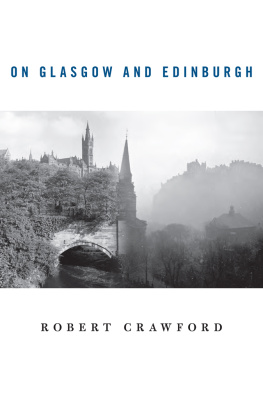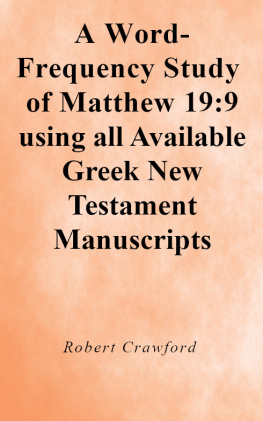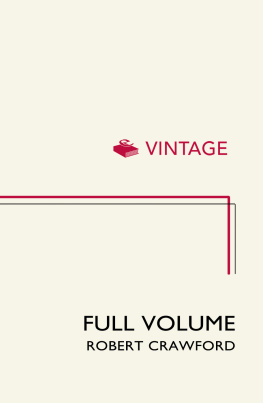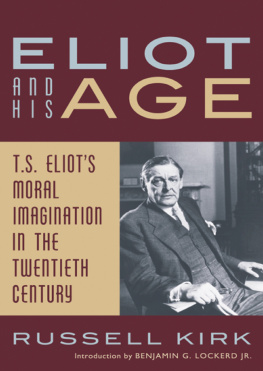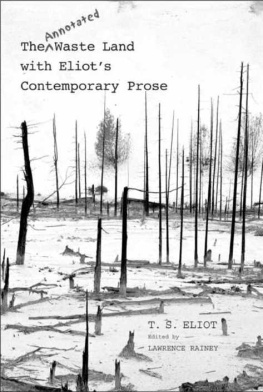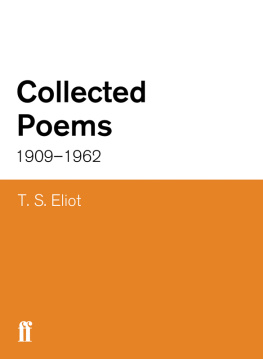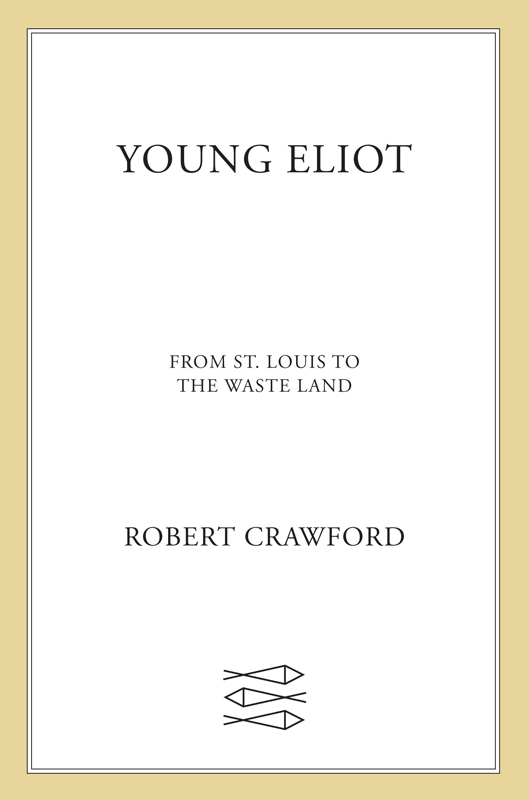Contents
Guide

The author and publisher have provided this e-book to you for your personal use only. You may not make this e-book publicly available in any way. Copyright infringement is against the law. If you believe the copy of this e-book you are reading infringes on the authors copyright, please notify the publisher at: us.macmillanusa.com/piracy.
for Alice

T . S. ELIOT was never young. That, at least, is the impression many readers get from his work. I grow old I grow old complains the voice of The Love Song of J. Alfred Prufrock, written when the poet was at the start of his twenties. A few years later Eliot began another poem with the words Here I am, an old man. Still in his early thirties when he published The Waste Land in 1922, he argued that the most important personage in the poem was Tiresias, who has already foresuffered all and appears to have lived for thousands of years.
Yet Eliot knew what it meant to be young. To follow his development from early childhood enhances alike reading of his work and understanding of his life. Presenting him as shy, sometimes nave and vulnerable, Young Eliot aims to unsettle common assumptions about this poets perceived coldness. It shows how his American upbringing combined with experience of France and England to make him not only the most remarkable immigrant poet in the English language but also the most influential and resounding poetic voice of the twentieth century. His poetry embodies an almost limitless resonance.
Eliots youth remained vital even to his aged eagle tone and achievement. Back home, they did not tell Valerie what they had been up to. Instead, the septuagenarian business-suited Nobel Prize winner settled down to playing with his nephews remote-controlled toy Aston Martin James Bond car. In age, among those whom he trusted most, the poet nicknamed Old Possum retained a certain gleefulness. He remained young Eliot.
This elderly gentleman turned stink-bomber may have been making up for lost time. His own childhood had been unabashedly strict. A shy, big-eared boy whose privileged upbringing took place within earshot of one of the most seductive productions of African American culture ragtime music Tom Eliot in St Louis, Missouri, was not a child renowned for wild escapades. Yet just as his first book contains poems that are unsettlingly subversive in their rhythms, images and social satire so throughout his life, despite his po-faced, born-venerable public persona, there was an elusive, wounded and sometimes mischievous identity that remained a source of disconcerting creative energy. He once wrote of Alfred Lord Tennyson, the iconic English Victorian Poet Laureate, that he was the most instinctive rebel against the society in which he was the most perfect conformist. The same could be said of the author of The Waste Land .
Like most people to whom his poetry matters, I fell in love with the ineradicably insinuating music of Eliots verse. More than forty years after I first read it, there are still things about the poetry that puzzle me, luring me on; but I knew from the start, and writing his biography has confirmed the conviction, that Eliots poems work not because they are intellectual games but because they are the products of an intense emotional life fused with a preternatural mastery of the pliancy of language. Like Tennyson and a very small number of other English poets, Eliot had perfect pitch when it came to the music of words. Yet if his hearing was the source of his greatest gift, then, ironically and absurdly, from very early childhood he hated his own ears. Their large size and shape caused him acute embarrassment, deepening his boyhood shyness. What he managed to do was to turn that apparent source of affliction into his greatest artistic asset. Repeatedly, whether in the case of his shy self-consciousness, or his later sense of sexual hurt, or his experience of death, or his raw sense of having made terrible mistakes in his life, Eliot faces up to a wound, a humiliating source of pain, and, through confronting it, incorporates it into an emotionally resonant, brilliantly intelligent work of art. His poems have their sources in word-music and in such acts of moral or emotional courage as well as in sheer technical mastery. However absurd or tortured on occasion, Eliots life and his transformation of aspects of it into verse are the work of a great poet. Coming to terms with insistent personal damage, he was able, as few have been able, to make works at once insistently new and abiding.
T. S. Eliot did not want his biography written. Much of his most intimate correspondence, including many letters to his parents and almost all of his correspondence with his first wife, was destroyed at his own request. Having managed to make lasting poetry out of his most stinging humiliations, he wished those humiliations to be afforded the grace of oblivion. Consistent with a good deal of his criticism, which stressed poetic impersonality, his efforts to suppress his own biography were sometimes devastatingly successful. Between the summer of 1905 (when Eliot was sixteen) and the winter of 1910 (when he was twenty-two) all that survives of his correspondence is a single postcard. This is one reason why the few biographers who have attempted to write his life tend to pass over the first twenty-one years in around twenty-one pages. I owe these biographers great debts, and believe biography affords not a reductive explanation that undoes the mystery of an authors gift, but a form of artistic narrative attention that averts caricature and illuminates both poet and poetry. Nevertheless, earlier biographies of this particular poet are misleadingly proportioned. Eliots formative years were exactly that. Their importance is greater than most readers have realised. Young Eliot presents this crucial period in much more detail. Home is where one starts from.
Though Eliot wanted no biography written, he did grant Valerie Eliot permission to edit his letters. After he died in 1965, she worked for decades to build a superb archive of the poets correspondence, drawing not just on carbon copies (many held in the archives of the London publishing house of Faber and Faber, of which Eliot was a director), but also on original letters which Mrs Eliot acquired, often through auction houses. Along with much of Eliots library, this reassembled archive grew to complement the massive assemblage of Eliot materials housed now in the Houghton Library at Harvard, a collection which owes its origins to the poets mother and brother; it complements, too, the bequest given to Kings College, Cambridge, by Eliots friend John Hayward. Other substantial hoards developed at locations from Leeds to Texas and from London to New York and New Zealand. Recognised as a figure of global importance, Eliot has long attracted ambitious manuscript collectors. When, not long after his death, some typescripts and other drafts of The Waste Land were revealed among the holdings of the New York Public Library, Valerie Eliot produced an impressive scholarly edition of these. In 1988 she published the first volume of her late husbands letters; a much expanded second edition of this appeared in 2009 along with the long delayed second volume. By that time, Mrs Eliot was unwell and these books were co-edited by Professor Hugh Haughton. Now Professor John Haffenden continues to edit The Letters of T. S. Eliot . Several thousand pages are in print, with many thousands more yet to be published.


